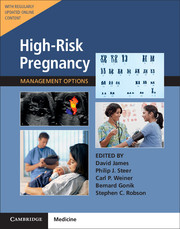Book contents
- Frontmatter
- Contents
- List of Contributors
- Preface
- Section 1 Prepregnancy Problems
- Section 2 Early Prenatal Problems
- Section 3 Late Prenatal – Fetal Problems
- 9 Prenatal Fetal Surveillance
- 10 Fetal Growth Disorders
- 11 Disorders of Amniotic Fluid
- 12 Fetal Hemolytic Disease
- 13 Fetal Thrombocytopenia
- 14 Fetal Cardiac Arrhythmias
- 15 Fetal Cardiac Abnormalities
- 16 Fetal Craniospinal and Facial Abnormalities
- 17 Fetal Genitourinary Abnormalities
- 18 Fetal Gastrointestinal and Abdominal Abnormalities
- 19 Fetal Skeletal Abnormalities
- 20 Fetal Tumors
- 21 Fetal Hydrops
- 22 Fetal Death
- Section 4 Problems Associated with Infection
- Section 5 Late Pregnancy – Maternal Problems
- Section 6 Late Prenatal – Obstetric Problems
- Section 7 Postnatal Problems
- Section 8 Normal Values
- Index
16 - Fetal Craniospinal and Facial Abnormalities
from Section 3 - Late Prenatal – Fetal Problems
- Frontmatter
- Contents
- List of Contributors
- Preface
- Section 1 Prepregnancy Problems
- Section 2 Early Prenatal Problems
- Section 3 Late Prenatal – Fetal Problems
- 9 Prenatal Fetal Surveillance
- 10 Fetal Growth Disorders
- 11 Disorders of Amniotic Fluid
- 12 Fetal Hemolytic Disease
- 13 Fetal Thrombocytopenia
- 14 Fetal Cardiac Arrhythmias
- 15 Fetal Cardiac Abnormalities
- 16 Fetal Craniospinal and Facial Abnormalities
- 17 Fetal Genitourinary Abnormalities
- 18 Fetal Gastrointestinal and Abdominal Abnormalities
- 19 Fetal Skeletal Abnormalities
- 20 Fetal Tumors
- 21 Fetal Hydrops
- 22 Fetal Death
- Section 4 Problems Associated with Infection
- Section 5 Late Pregnancy – Maternal Problems
- Section 6 Late Prenatal – Obstetric Problems
- Section 7 Postnatal Problems
- Section 8 Normal Values
- Index
Summary
Introduction
Craniofacial anomalies include a wide spectrum of malformations. They may be clinically relevant in themselves, and may also be associated with other congenital anomalies, or be a part of a syndrome.
Central nervous system (CNS) malformations are some of the most common congenital abnormalities encountered at birth. The true incidence of these anomalies is however probably underestimated, as most epidemiologic surveys are based on clinical examinations performed in the neonatal period, while many cerebral malformations will only be discovered later in life. Long-term population-based studies indeed suggest that the incidence may be as high as 1%.
Detection of CNS anomalies was one of the most compelling motivations for the routine use of sonography in pregnancy. It is now clear that open neural tube defects including anencephaly, open spina bifida, and large cephaloceles, as well as other severe malformations such as major holoprosencephaly, are readily identified in early gestation. In fact, the major challenge for the fetal medicine specialist is more to interpret findings of uncertain clinical significance than to detect serious cerebral malformations. Many subtle anomalies that are poorly understood, such as ventriculomegaly, agenesis of the corpus callosum, and posterior fossa cysts, are now detected antenatally. As there is no clear-cut correlation between abnormal anatomy and long-term cerebral function, the consequences of these anomalies are difficult to predict. This causes anxiety for parents, requires difficult decisions, and may eventually lead to the loss of normal fetuses.
Most recent national guidelines include visualization of the fetal face in the standard examination of fetal anatomy. Documentation of the fetal eyes and lips is recommended. Malformations of the face and skull include many different entities. Most of them can be treated effectively after birth. However, the association with syndromes and multiple anomalies is frequent.
Normal Sonographic Anatomy of the Fetal Head and Spine
Standard sonographic examination of the fetal brain is commonly performed at the end of the first trimester (11+0–13+6 weeks’ gestation) and during the second trimester (especially 18+0–23+6 weeks) (see Chapter 7).
- Type
- Chapter
- Information
- High-Risk Pregnancy: Management OptionsFive-Year Institutional Subscription with Online Updates, pp. 365 - 408Publisher: Cambridge University PressFirst published in: 2017



